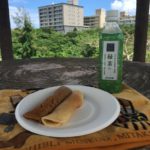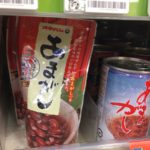On the 5th month 4th day of the lunar year is a day known as yukkanuhi ユッカヌヒー, meaning “4th day” in Okinawan language. It is to pray for good luck in fishing and maritime activities and a celebration day with traditional haarii ハーリー (dragon boat) races. This usually close to the end of the rainy season here in Okinawa. This year (2017) it will be Monday May 29th. Although I am supposed to go to work that day, I would really like to go watch the haarii…
On the 5th day of the 5th month, known as gungwachi gunichi グングヮチグニチ (五月五日, meaning “5th month 5th day” in Okinawan language), is Boy’s Day, also known as Children’s Day in the Japanese calendar (orginally “tengu no sekku” 端午の節句).
It is traditional to serve popo ぽーぽー and chinpin ちんぴん on these 2 days; it is also placed on the ancestors altar or the hinukan as an offering to pray for good health and prosperity of boys/children/family, as well as for ocean safety and good catches for fishermen.
It is also traditional to place irises (shoubu 菖蒲) and another type of sweet dish called amagashi アマガシ (or あまがし) on the altar or hinukan during these days in Okinawa.
Amagashi is sort of like a mix between amazake 甘酒 and zenzai ぜんざい; red beans mixed with rolled oats (wheat or barley), mung beans, rice koji, and brown sugar (it ferments for 2-3 days after making it). It used to be eaten with the leaves of the irises, but I have my doubts that it is common any more. It is possible to find pre-made in the local grocery stores, next to the zenzai cans and packages. It can be made with either Japanese azuki beans or red kidney beans, though the red kidney beans are actually more common due to the American influence after WW2, making them cheap and accessible.




